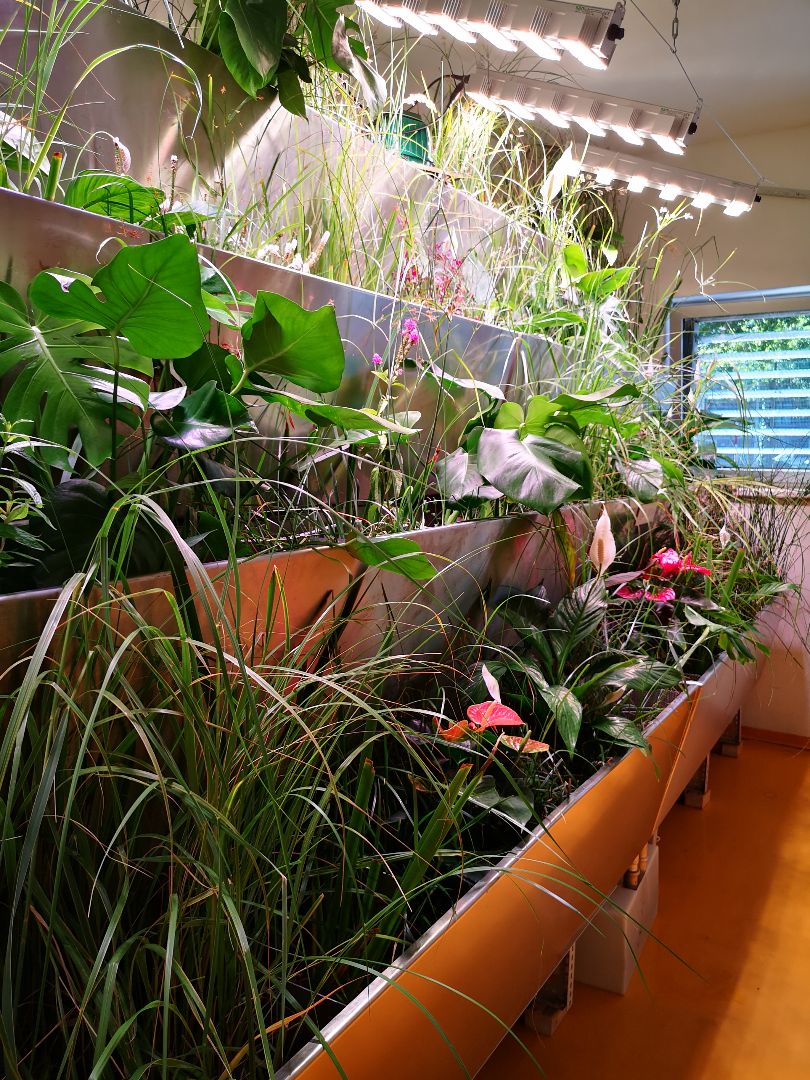Theresa Heitzlhofer is responsible for the interlinking between people and technology at alchemia-nova and, as part of the stand-up innovation #tomorrow living event, thought about how we will live tomorrow and not which technologies we will use, but how will it work out for us humans then feel what will change.
What is HOUSEFUL?
The main topic at alchemia-nova is circular economy with NBS. In the EU HOUSEFUL project, we are working on combining eleven circular solutions, such as gray water treatment with vertical green walls and biogas, with the aim of making existing buildings as circular as possible.
Some of these solutions are being implemented in existing buildings in Spain and Austria. In Austria, the first changes are currently being implemented in the 14th district and in the Cambium community in Fehring, Styria. In Vienna the wastewater flow from the building is separated into liquid and solid components. Solid components (kitchen waste, faeces, toilet paper, …) are converted into biogas in a household-sized biogas plant, which can be used as cooking gas. After a special composting process, the residue is transformed into fertilizer for food production on site. All liquid components are processed indoors and on the building facades via vertical herbal sewage treatment systems, the organic nutrients are stored in the plant biomass and, after composting, also converted into fertilizer. The purified water is used for watering the garden or for flushing the toilet.

HOUSEFUL needs many people
In the course of the first planning we noticed that most of the existing technical solutions are better applicable for larger households or for apartment buildings. This circumstance brings with it social aspects. It makes no sense to want to be completely self-sufficient, but rather buildings have to be thought of in clusters, in associations, in order to keep organic recyclables as long and ecologically sensible as possible. A practical experience from our Labscale in our office in Baumgarten: our employees are now bringing the organic waste from home with them in order to bring the biogas system to full capacity. In the demonstration building for HOUSEFUL in Styria, we don’t have the problem, as a lot of people already live together in a former barracks.

“It takes an emotional bond for participation”
When I started my diploma thesis on “Participation in the Context of Sustainable Development” in 2005, it was clear that participation only works if there is an emotional bond between people and the place. This emotional connection is absent in most residential contexts. In single-family houses, in apartments rented out for a limited period of time with little contact with neighbors. But such a bond is currently not necessary, and often not even desired. In Austria and other places around the world there are examples of cooperative housing projects in which living neighborhood is an important aspect – in these buildings such an emotional bond is very possible and, to my knowledge, also takes place.
How do we get this WE feeling in other multi-party existing buildings? Is circular living only for alternative housing projects?

(c) Cambium: Leben in Gemeinschaft
If my wastewater is treated many kilometers further and no one can trace my wastewater back to me, then I can dispose of pretty much everything in the toilet. If my rubbish is handled centrally, I can pretty much throw everything away here too.
Assuming that a local sewage treatment plant is built in an existing multi-party building, or even a joint biogas plant. Even if there is someone on site responsible for maintenance.
THE SOCIAL CONTACTS WILL INCREASE AROUND THESE FACILITIES.
The local treatment of wastewater and the recovery of nutrients as well as the use of these for local production will occupy the residents. Certainly not everyone will participate, not everyone will be interested in the effectiveness of the systems, and not everyone will intervene in the event of a fault. But even if some of the residents are interested, we win:
- more social interactions,
- more interest and knowledge about NBS (Nature Based Solutions)
- more awareness of the effects of our way of life
With this resource-based approach, we enrich the social interactions and the participation behavior of residents with an application-oriented aspect. This can help to question and realign current and future ways of life – and that is exactly what we need for sustainable development.
In order to achieve ecological, social and economic sustainability, we have to share MUCH MUCH more than we do today. It doesn’t have to go as far as the Viennese word “Haberer” describes – people who shared a bed at the turn of the last century – but much further than what happens today. Big sharing has not yet made it into the mainstream. With the resource-based approach that we are pursuing in the HOUSEFUL project and the new digital possibilities, we can do this much more easily.
The (combination of) new technologies requires new ways of life, new ways of living together, new mindsets – which are open to NBS. The IBA shows lots of projects that can promote the development of new mindsets.
Desired requirements for new buildings
In addition to the mindset, I also have a very specific, technical, easily solvable wish for future buildings: separate wastewater management in the new building in order to be able to respond better to various resource flows, to bring back what is possible, to keep it decentralized in a circle for as long as possible – about our primary storage facilities and to relieve the waste disposal sites – to get to know our neighbors – to save our wallets.
Incidentally, this can all be done with a mask.
Would you like to live in a HOUSEFUL Buidling? Whatever your answer, you should come to our laboratory-scale demonstrations in Baumgarten, 14th district or Cambium (Styria) to see the implementation of a HOUSEFUL house. Contact us for a visit by email th@alchemia-nova.net.



